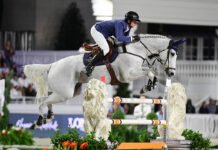While the hands may be voted the superstars of communication with your horse, the elbows are the true unsung heroes of the riders’ arms. They can make or break a horse’s ability to carry herself in a relaxed and balanced frame. When elbows go backward, they throw both the rider and the horse off balance. That’s because as the elbows go back, the rider’s shoulders end up rolling forward and her upper body follows. As the rider tilts in front of the vertical, the horse carries more weight over her forehand – the last thing we want her to do. Even a slight tip of the rider’s body will be felt by the horse, alter her carriage, and interfere with her performance. Additionally, the rear-facing-elbow pulls back on the horse’s mouth and draws her chin toward her chest. You might think, “This won’t happen if your reins are long enough,” but you’d be wrong. Even with a long rein your horse is sensitive enough to feel the direction of pull and to feel the effects. Of course if your reins are short the impact will be even greater. It will cause unyielding bit pressure from which the horse cannot find relief.
The cure for all these problems is simple: Push those elbows forward! They should be slightly in front of your body so that your hands hover slightly above and to the sides of your horse’s withers. In this position, your shoulders can settle back over your hips so you can sit tall and proud in the saddle (and help your horse move better!). Some rider’s elbows go back because they are trying, perhaps unconsciously, to feel safer in the saddle. However, it’s a false sense of security and a habit that is wise to work on letting go.
Backward elbows create heavy hands, but successful communication with your horse requires a light touch. That’s your arms’ only–but absolutely essential–purpose when you’re riding your horse: to provide clear yet gentle communication and support. It’s supple forward-facing elbows following your horse’s movement that make that happen. By mirroring every subtle change in the position of her head and neck, your horse can relax, carry herself in comfort, and enjoy having a rider on her back.
Test Your Equestrian IQ:
Leading a Horse: What’s Wrong with This Picture
Dale Rudin is a CHA-certified riding instructor and clinician with a mindful and balanced approach to horsemanship and riding.
www.un-naturalhorsemanship.com






